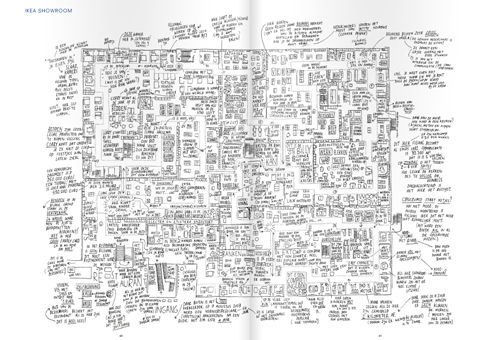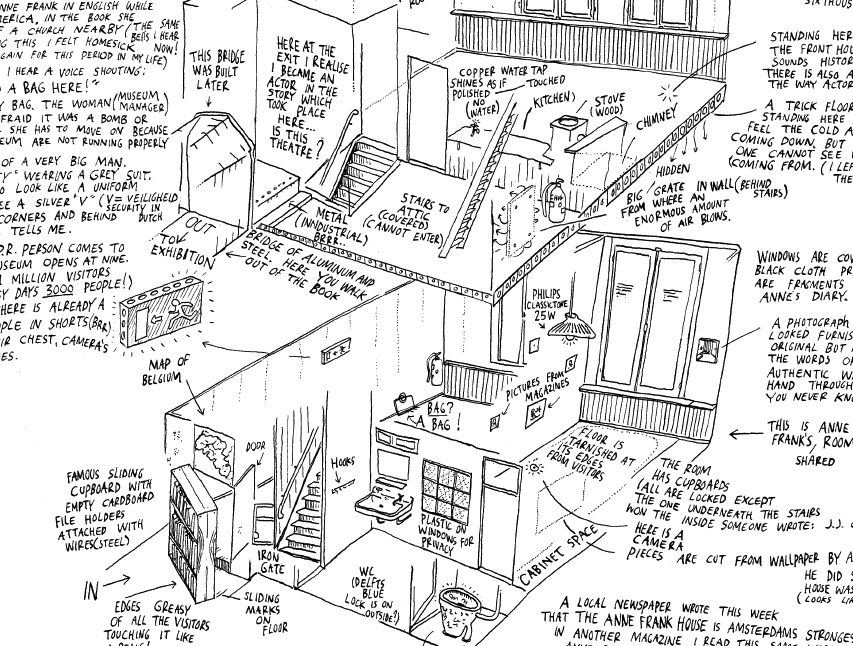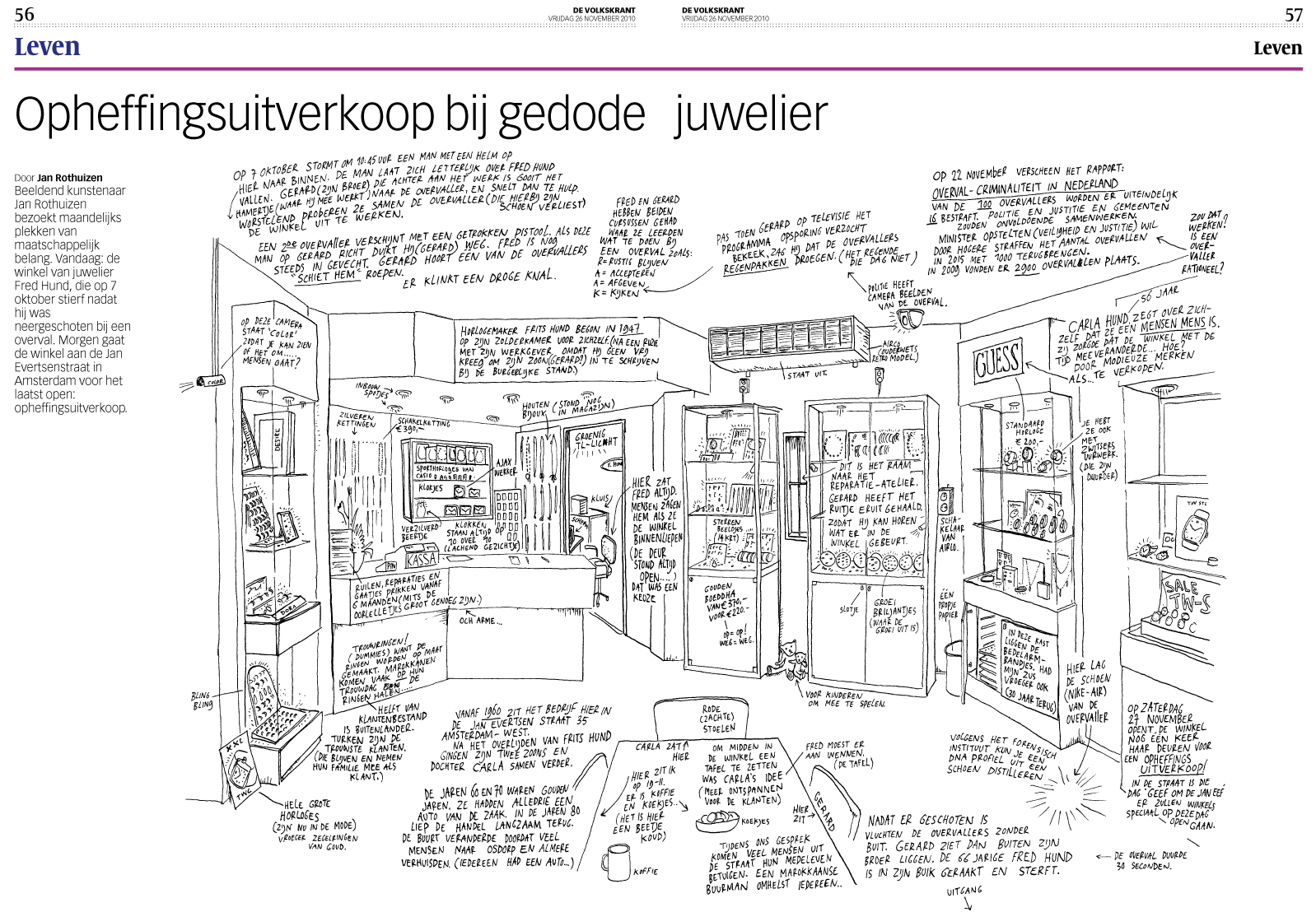Dutch artist Jan Rothuizen has developed a very special and entertaining kind of topographical journalism, which allows him to leave the usual platforms of the art circuit behind.
MePri: You have been making this kind of supra-factual or “soft”- cartographies since 2005 in various international megacities: Guangzhou, Cairo, Beirut and in your native town Amsterdam. Can you describe, how this idea developed?
Jan Rothuizen: After I left art school where I was trained to become a painter I lived in New York for a few years. It was there – in 1998 – that I found myself making excuses to escape my studio and wander the streets. After a year I came to the conclusion that I was a better artist, when walking through a city than when working on paintings in the confinement of my studio. While wandering, I felt my experience of place was a fertile state of being. Although I did not yet make the kind of maps I do now, there was already a lot of interaction with my surroundings. The works I produced resulted in my first book On a clear day you can see forever.

Lebanon Beirut; Ain Mareisse. On this map one can see the location where president Rafik Harriri was killed by a car bomb. The investigation about his death is today the reason for political unrest in Lebanon (For enlargement of the images please use the magnifier function of the slide show below)
MePri: Your Soft Atlas of Amsterdam (De zachte Atlas van Amsterdam) is very successful, now in its fifth edition. Is it predominantly bought by locals or also by tourists?
J.R.: The book sells of course good in Amsterdam, but it does surprisingly well in other cities.
MePri: Do you know of any readers following your routes?
J.R.: The book is not to be used as a guide although you can look up places that you might have visited, like the supermarket you will find in every town in Holland or the Anne Frank house. But there are also places in the Atlas that one rarely visits, like the prison, the room drug addicts use to shoot or smoke dope, the Mayor´s office. The Atlas mainly functions as an armchair traveller. It is possible to get some sense of place by reading and looking at the drawings. We are working now on an English edition.

Het achterhuis, The Anne Frank house in Amsterdam.
MePri: To me the unique thing about your topographical drawings is the idea of a spatial entity of commenting voices, which seems to be far away from the narrative approaches of graphic novels. Your performance Scripted Spaces from 2000, where you transcripted an ethereal landscape shaped by a dense carpet of sound of simultaneously played radio broadcasts, seems to play a key role in the formation of the idea of combining spaces, voices and writing. Am I right in assuming that this project was a kind of starting point?
J.R.: I never thought of this particular work as a starting point, although it is a map of the sky filled with voices and melodies. In retrospect I feel the homeless signs I bought from people in the streets of New York come closer to the drawings I do now. On the back of each of these signs, I wrote a little text about where I bought the sign for how much, and I described in short the situation. What kind of person was it that sold the sign to me, how much did I pay for it and also very important, how did I feel about this? This was written like a small reportage.
MePri: Last year you made a series of drawn topographical reports for the Dutch national newspaper De Volkskrant. How did you select the sites for these drawings and how did you proceed after the selection process?
J.R.: First of all I have to be curious about a subject or site. I do find most places interesting though. When people say something is not interesting because nothing happens there I get even more interested. Something is always happening there. For my drawings, I look for subjects that say something about today’s society. For example, I wanted to do something about the war In Afghanistan, but not in an exotic or sensational way. I learned about the parents of a soldier who was killed in action that they their sons bedroom untouched. In this drawing, I was able to portray not only the 19-year-old soldier but also his mothers grief, three years after he was killed by a roadside bomb.
I prepare like a journalist. I try to read and understand much about a subject. On location I concentrate on what is there, noises, smells and atmosphere. I like to compare my way of working with the way bats find their way around in the dark. Through echolocation they know not only where they are but also who and that they are, therefore it is ideally a form of becoming ones surrounding.

Drawing of a fallen soldier´s bedroom three years and three days after he was killed by a roadside bomb in Uruzgan Afghanistan.
MePri: Most of your works – if not all of them – are centred on the riddle of identity, on the construction of the persona. Accordingly your position as an author seems to be very versatile and variable one. You write novels, draw maps, publish in newspapers and exhibit in museums. The advantage is that you reach various levels of audience, the readers of the popular newspapers as well as the more exclusive circle of the art world. On the other hand you seem to be very definite in terms of identity in your request not to be confused with someone who works on commission, like a journalist or an illustrator. Concerning your self conception it is easy to understand, but why would it be important to reveal your identity as an artist e.g. to the readership of the De Volkskrant? Do you assume that they will receive your contribution with another kind of awareness and intensity?
J.R.: I considered it a great benefit to make work that functions outside the art circuit. Making books and publishing in newspapers is the most favourable platform to show my work. I like the idea that people stumble upon my drawings in their daily routines. Although I do think of myself as a visual artist, showing work in a museum and galleries is nowadays less appealing to me.
I am keen to state that I am an artist because it gives not only me but also the people who read my drawings some freedom. If I would present myself as a journalist I would proclaim objectiveness and truth. In my drawings all is subjective and although I explain and show things as they are there is no hierarchy of information. There is room for unexplained details that seem of no importance.
I also feel that the form of drawing is slightly detached from reality. I can show and say things photography cannot. I am also curious to explore more subjects that are difficult to portray in an ordinary photographic manner.
MePri: Detective approaches like criminal investigation, search for clues, crime scene description etc. seem to be of repeated interest in your work. How would you describe your relationship to murder mystery, this central myth of our time?
J.R.: I look for clues on location to describe what I feel. Like a novelist I rather show than tell. Someone recently recommended the books of Sherlock Holmes to me. I am not a great fan of crime novels, but I do love drama, its everywhere!
>Slideshow: Soft maps by Jan Rothuizen (6 images)
————————————————————————————————————————–
MePri-News 1-2-12
New Publication: The Soft Atlas of the Netherlands
After the unexpected success of his drawn topographical report The Soft Atlas of Amsterdam (De zachte Atlas van Amsterdam) Dutch artist Jan Rothuizen recently published a further “soft ” or supra-factual cartography of the Netherlands. De zachte Atlas van Nederland encompasses a wide range of topics: A gas station, a Frisian classroom, the room of a 90-year-old woman who still live independently, the bedroom of a soldier fallen in Afghanistan, an IKEA-market etc.

Jan Rothuizen: IKEA showroom






